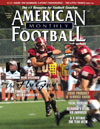AMERICAN FOOTBALL MONTHLY THE #1 RESOURCE FOR FOOTBALL COACHES
Article CategoriesAFM Magazine
|
30-Stack Pressure Defenseby: Jim GirardHead Coach, Dover-Sherborn High School (MA) © More from this issue When we went to the 30-Stack defense as our base defense, we did so for a few reasons. First, it suited our personnel. Traditionally, we are a school that does not have great size, but we were fortunate to have athletes who could run. This defense allowed us to feature our greatest asset: team speed. Second, we liked the idea of being in a defense where we could show a lot of different looks to opposing offenses in terms of fronts and coverages without having to change personnel. The 30-Stack offered us this versatility and flexibility. But what our staff and our players liked most was the fact that it was a pressure defense. It is a “fast-break.” A lot of kids get the chance to make plays due to its blitzing capabilities. So playing it and watching it is fun and exciting. As offenses continue to grow mor....The full article can only be seen by subscribers. Subscribe today!
|
|
|||||||
| HOME |
MAGAZINE |
SUBSCRIBE | ONLINE COLUMNISTS | COACHING VIDEOS |
Copyright 2025, AmericanFootballMonthly.com
All Rights Reserved





